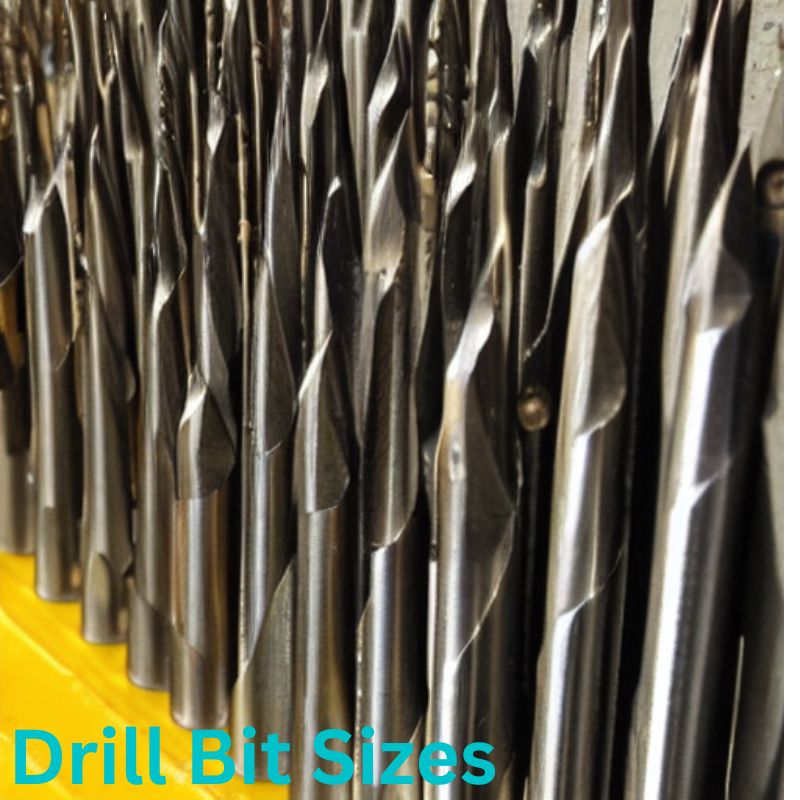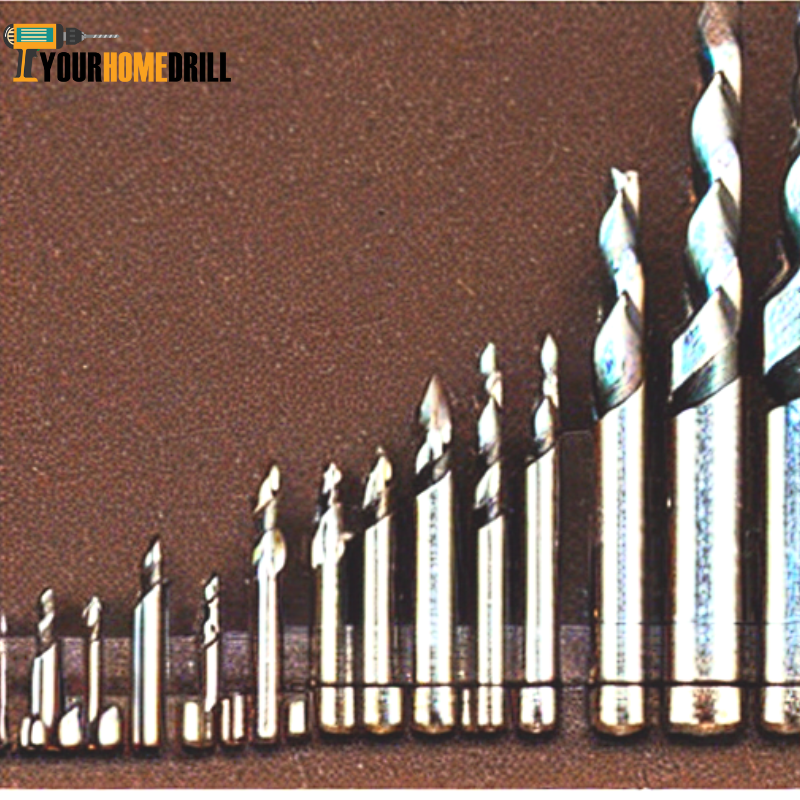The size of the drill bit refers to the diameter of the tip, with a number 7 drill bit measuring 0.201 inches (5.08 mm) in diameter. Drill bit number gauge sizes range from size 80 (the smallest) to size 1 (the largest).
In this article, we will talk about why it is important to know the sizes of drill bits and what types of material you will be working with when buying yours.
It is generally considered a medium-sized drill bit and is often used for general-purpose drilling and for drilling pilot holes for larger screws and bolts.
It is important to note that the size of the drill bit should be appropriate for the material you are drilling into and the size of the hole you need to create. Using the wrong size drill bit can result in a poor-quality hole or damage to the material.
Different-sized drills are needed depending on what you want to do!

What Size Number 7 Drill Bit?
Number seven (7) drill bits are typically either spade-shaped or round. Spade-shaped number 7 bits have a very sharp edge which allows for more efficient cutting but requires more frequent changing of the bits due to dulling of the tip.
Round number 7 bits do not have this problem as they can be rotated in any direction, however, they may take longer to break down and wear out slightly than spade-shaped bits.
What size number 7 drill bit should you buy? That depends on your purpose for having a drill!
There are some things that require a spade bit like drilling metal, plastic, or hardwood, while other materials like drywall or plaster can be done with a normal rounded bit such as a #4 or #5. It will also depend on how much pressure you can apply to the tool while drilling.
What is the difference between a number 7 and a number 30 drill bit?
A number 7 drill bit has a wider shank than a number 30 drill bit, which helps create more space in your hole for heavier materials like wood or drywall. However, this also means that you will need more bits to complete a project!
Number 7 drills are usually one size larger than a normal number 30 drill bit because of the extra wide shank. Some people even use them as a safety net when drilling very hard material such as plasterboard or steel. It will not break easily if you drag the tool across a thick shaft.
What is the difference between a number 7 and a number 11 drill bit?
The size of a number seven drill bit comes down to how thick you make it. There are two reasons for this!
Reason 1: In order to rotate at the same speed as thinner bits, bigger-diameter bits require more power. More powerful motors or battery sources will not work with thin, low-quality drills.
Reason 2: It has to do with cutting efficiency. A thicker drill bit takes longer to cool after being used, which means less time for the re-melting of existing chips and the creation of new ones. This results in weaker drilling and lower accuracy.
Thicker drill bits are also heavier, which can be very inconvenient when doing so many things.
What is the difference between a number 7 and a number 4 drill bit?
The only significant difference between these two bits is their diameter. A number 4 drill bit has a larger diameter than a number 7, making it more efficient for drilling thicker materials.
However, this doesn’t mean that you should go out and buy a number 4 every time there is a need to make a hole through a thick material. That would be very expensive!
Instead, you can use both types of drills in various applications. For instance, if you are just starting out with your tool collection or you are a beginner working with thinner materials, then get yourself a couple of each size drill bit.
As you progress as a woodworker, you will eventually run into situations where you will need to work with thicker materials so you will have a backup plan when you run out of either type of drill bit.
What is the difference between a number 7 and a number 3 drill bit?
A number 7 drill bit has very rounded, slightly curved edges that are not as sharp as a number 3 drill bit which has sharper, more angular-shaped chips. This shape is much easier to achieve good quality sanding with, and most people use this type of bit when doing final touches like smoothing out wood or taking down hard layers of paint.
A number 7 also uses less dust than a number 3 bit because there are smaller openings at the end where dirt and chips get trapped. It becomes harder to produce smooth results when these particles stick to other parts of your tool that will need to be cleaned later.
What is the difference between a number 7 and a number 2 drill bit?
A number 7 drill bit has wider cutting edges or flats than a number 2 drill bit. The wider flat makes it more efficient in drilling hard materials like steel, aluminum, or plastic. This also means you will need less frequent changes of bits to make the same hole size!
Drill bit numbers are actually determined by how many notches there are in the front face of the drill bit. There can be one, two, three, or even as many as eight notches depending on what material you are drilling through. The longer the notch, the larger the fluted drill bit that comes out of the end.
The number next to the notch determines which edge gets called a “cutting” edge and which gets called a “flat” or “landing” edge. These names describe their function better I think.
A number 2 drill bit only has one cutting edge and one landing edge so it takes longer for it to break down and require replacement. A number 7 drill bit has both a long, sharper cutting edge and a shorter, slightly curved landing edge, making it last longer without needing replacing as often.

What is the difference between a number 7 and a number 1 drill bit?
A number 7 drill bit gets its name because it has seven cutting edges, whereas a one-edge-per-chip drill bit only has one edge.
Seven-edged bits are typically twice as strong as one-edged ones! This means that you will need half the amount of drilled material to fill in holes made with a seven-edged bit than with a one-edged bit.
The reason for this strength difference is that each individual edge in a seven-edged bit can be sharper and more durable than an average one-edged chip cutter.
What is the difference between a number 30 and a number 11 drill bit?
A number 30 drill bit has an extremely thin, sharp edge that is almost flat. This makes it perfect for drilling very fine or light holes. It also requires less power to use because you do not need to apply as much pressure when using a number 30-bit.
A number 11 drill bit has thicker sides than a number 30 bit. The thicker end of the bit can handle heavier loads but will take longer to finish your hole. Therefore, this size needs more power to complete the job faster but may require more solid drills due to the extra strength needed.
You should be aware of both types of bits in order to efficiently master hand drills.
What is the difference between a number 30 and a number 4 drill bit?
The edge of a number 4 drill bit is very thin, sharp, and barely wider than the diameter of the hole it is being pressed into. This edge does not hold much power, which is why you often need several passes to create a good cut.
A number 4 bit will also break down quickly because it doesn’t last long before needing to be replaced.
Number 4 bits are great for drilling out small clumps or pieces that have hard shells like nails or screws. They are also helpful in creating a smooth surface when drilling plastic materials.
However, they are not ideal for longer drills as they may fracture from the pressure needed to keep going. Partly due to their lack of strength, speed is reduced too since there is less torque being applied to the material.
A better choice for longer lengths is the number 30-bit, but these take longer to cool and re-chisel after hitting harder materials.
FAQ’s
What size is a 7.5 mm drill bit?
A 7.5 mm drill bit has a diameter of 0.295 inches (7.5 mm). This drill bit size is considered a medium-sized drill bit and is often used for drilling wood, plastic, and softer metals such as aluminum.
How do you size a drill bit?
To size a drill bit, you measure the diameter of the tip of the bit. This measurement is usually given in inches or millimeters.
so it’s always good to check the specifications or compare it to a known size for confirmation.
What are the 3 types sizes of drill bits?
There are three main types sizes of drill bits: small, medium, and large.
Small drill bits typically have a diameter of 1/16 inch or less and are used for precision drilling,
Medium drill bits typically have a diameter of 1/16 inch to 1/4 inch and are used for general-purpose drillings, such as drilling wood, plastic, and softer metals like aluminum. They are also commonly used for drilling pilot holes for larger screws and bolts.
Large drill bits typically have a diameter of 1/4 inch or greater and are used for drilling larger holes, such as those needed for pipes or electrical conduits. They are also used for drilling through thicker materials, such as metal or masonry.
It’s also worth noting that the classification of the drill bit size is not fixed and it can vary depending on the manufacturer and user’s needs.
Conclusion:
In this article, I hope this will be helpful for your guidance about what size number 7 drill bit and many other differences with the other drill bits.
Thanks for the reading.
